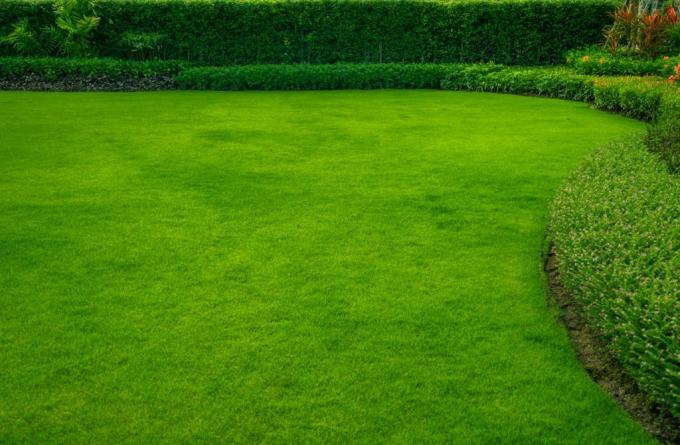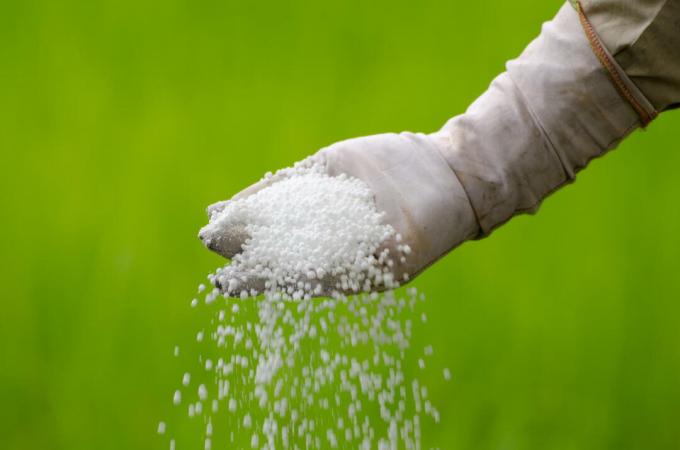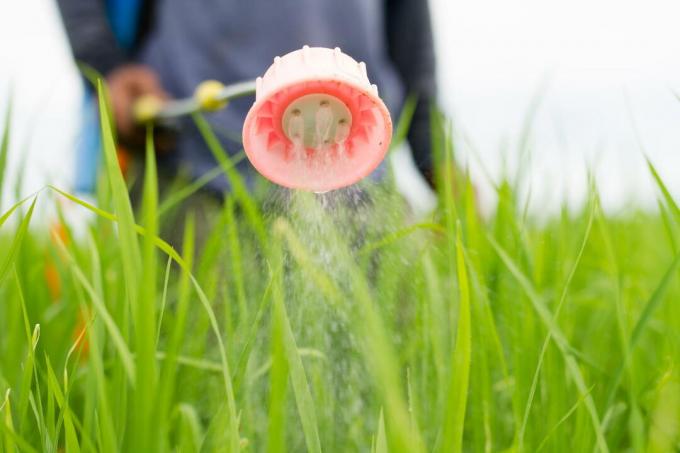When it comes to nutrient supply, lawns are very demanding. We will introduce you to different lawn fertilizers and make a comparison.

The choice of lawn fertilizer not only determines the nutrient supply of the lawn, depending on the type of fertilizer chosen, the frequency and comfort of the lawn also differ Application, the risk of over-fertilization or leaching, the effect on the lawn plants and the soil and, in the long term, even the subsequent need for watering, scarifying or Aeration. With the presentation of the most diverse types of lawn fertilizers, we want to give you an overview so that you can find exactly the lawn fertilizer that has the most advantages.
contents
-
Organic lawn fertilizer
- Organic lawn fertilizer
- Long-term organic lawn fertilizer
-
Mineral lawn fertilizer
- Iron fertilizer for the lawn
- Blue grain for the lawn
- Nitrogen fertilizer
- Liquid lawn fertilizer
- Lawn fertilizer with weed killer
- The best lawn fertilizer
Special iron fertilizers, liquid fertilizers, nitrogen fertilizers, blue grain and lawn fertilizers with weed killers are all mineral lawn fertilizers. Liquid fertilizers and nitrogen fertilizers are also available in organic form and organic fertilization in particular offers many advantages, such as a natural long-term effect. Organic lawn fertilizers also have these advantages due to a high proportion of organic material, so that after a detailed comparison we ultimately consider them to be the best lawn fertilizers.
Organic lawn fertilizer
The difference between organic and mineral lawn fertilizer lies in the "packaging" of the nutrients. While mineral fertilizers are available as pure salts of nutrients, organic fertilizers are bound in naturally grown structures. This has a number of advantages:
- These structures not only contain some main nutrients, but also various trace elements.
- It also contains a large number of carbon compounds, for example in the form of cell walls, carbohydrates and wood pulp (lignin). If there is a little more carbon or if the living conditions of the soil organisms are not optimal, some of the material remains unprocessed. From these half-decomposed materials, new humus molecules are formed in biological and chemical processes, which represent a kind of carbon and nutrient storage in the soil.
- Humus molecules also have special properties that greatly increase the quality of the soil.
- In addition to plant nutrients, the introduction of organic material also provides the basis of life for many extremely useful soil organisms and material for building new humus. This is particularly important because soil organisms, when there is a high level of nutrient input, make use of the carbon reserves of the soil without the provision of organic material: the existing humus.

The conversion of organic material into the soluble nutrients that plants can absorb takes a certain amount of time. Finely ground organic lawn fertilizers release nutrients for the lawn faster than coarsely ground fertilizers. Warmth, humidity and a neutral to slightly higher pH value accelerate the work of the microorganisms. Nevertheless, organic lawn fertilizers must always be fertilized in advance: You should fertilize organically about a month before the nutrient requirement appears. More about organic lawn fertilizer can also be read in this article.
Organic lawn fertilizer
Both mineral and organic lawn fertilizers have their disadvantages: Mineral lawn fertilizers reduce the quality of the soil and organic lawn fertilizers have a delayed effect. The fusion of both types of fertilizer is organic-mineral and certified organic lawn fertilizer. The combination of organic and mineral components makes it particularly easy to effectively care for a lawn and the soil underneath. Organic lawn fertilizers have the added benefit that they only contain mineral components may also be used in organic farming: the sources are demonstrably as sustainable as possible exhausted. Organic lawn fertilizers are also available in animal-free form - including ours Plantura organic lawn fertilizer and Plantura organic autumn lawn fertilizer. As a result, they are not only less odorous and suitable for strict vegetarians or vegans, but are also more resource-efficient due to the lack of "food processing" in the production chain. Incidentally, some organic fertilizers even contain living microorganisms such as useful mycorrhizal fungi or special bacteria that release nutrients. More about the fertilizing properties of Organic lawn fertilizers learn from this article.
Long-term organic lawn fertilizer
Solid organic fertilizers always have a natural long-term effect. If humus is built up through the use, the brought in nutrients can even be used by the soil years later, if the soil experiences insufficient fertilization. This long-term effect arises from the time it takes for microorganisms to release nutrients. This also means that the release depends on the living conditions of these organisms. In the following table we have summarized for you what leads to a faster or slower release and how these factors can be influenced.
| Faster release | Slower release | Influencing |
|---|---|---|
| warmth | cold | Pay attention to the shadows cast by trees and buildings when installing |
| Sufficient moisture | dryness | Introduction of water-storing clay minerals, increasing the humus content for water storage, Frequency of mowing in summer (soil shading, cut stalks increase water loss), watering of the lawn |
| Good floor ventilation | Bad soil ventilation due to waterlogging / soil compaction | Increase humus content through organic fertilization, scarifying, aerating and sanding, organic fertilization to stimulate soil life |
| High nutrient content of the fertilizer | Low nutritional content | Choice of the right fertilizer, if necessary Incorporation of additional, difficult to decompose material in order to slow down the release or add nitrogen to accelerate it |
| Soil pH in the neutral range | Acid pH | Occasionally check the soil pH value and lime if necessary |
Tip: A quick release always means that less humus is built up. If you also fertilize organically with the aim of improving the soil, you should therefore not over perfect the working conditions of the microorganisms.
More information on the topic Long-term fertilizer for the lawn You will find here.
Mineral lawn fertilizer
Mineral lawn fertilizers contain the main nutrients nitrogen (N), phosphorus (P) and potassium (K) in mineral form. In addition, they often contain other nutritional elements that act as partners in the formation of fertilizer salt. Often advertised with high magnesium and iron contents, which should ensure a healthy, green lawn color. Most of the nutrients it contains come from fossil raw material stores, while nitrogen is converted from atmospheric nitrogen (N2) synthesized.
Mineral lawn fertilizers with three to six month long-term effects are increasingly being offered Should make your work easier for you, the user, and washouts are more or less good restrict.
However, mineral lawn fertilizers do not contain any organic components and completely bypass the natural conversion processes of the soil. By using only mineral lawn fertilizers, the soil becomes depleted in useful soil organisms and even loses parts of its humus body. This ultimately leads to a reduction in the quality of the soil. As a consequence, there can even be additional effort in maintenance: Scarifying and aerating are required more often, wild herbs can be promoted and fertilization errors are more serious.

Unfortunately, cheap mineral lawn fertilizers are often more heavily contaminated with cadmium, chromium or even uranium. These heavy metals can accumulate in the soil, in groundwater, in plants and finally through composting in the entire human food chain. Of course, there are limit values for exposure to toxic heavy metals in Germany and the EU, and these have also been revised downwards several times in recent years.
Tip: Incidentally, together with the reduction in soil quality, the consumption and hardly any recycling of phosphorus represent a major environmental problem: The Deposits for unpolluted rock phosphates will be used up in a few decades, and deposits with heavy metal-contaminated rock phosphates are already being used up utilized. Many experts are therefore of the opinion that the era of mineral fertilization in agriculture is over must be in order to conserve resources such as soil and nutrients and not other heavy metals to be entered.
Summary: Mineral lawn fertilizers
- In addition to nitrogen, phosphorus and potassium, they often contain magnesium and iron
- Organic components and other trace nutrients are missing
- Long-term mineral lawn fertilizers extend the fertilization interval and protect - depending on the type of processing - more or less against loss through leaching
- Sole use leads to a reduction in the quality of the soil and impoverishment of soil life, which results in additional horticultural effort
- In particular, cheap mineral lawn fertilizers are more heavily contaminated with harmful heavy metals
Iron fertilizer for the lawn
Iron is one of the 14 essential nutritional elements and is not only required by the lawn for the synthesis of various enzymes and chlorophyll. For this reason, it is often used in lawn fertilizers to create a very green lawn. Unfortunately, however, soil and nutrient chemistry is a little more complicated than some fertilizer manufacturers suggest: Iron is one of the most common elements in our soils. An absolute deficiency - i.e. the complete absence of iron - is extremely unlikely. It is much more likely that there is a relative deficiency that cannot be permanently remedied by iron fertilization, although plants only need very small amounts of iron. Optimizing the growing conditions for the lawn is the cheaper and more natural way represent to prevent an iron deficiency, because lawn grasses are able to iron very efficiently to record. You have an intake strategy that is unique in the plant world. So before you spend any money on something that is perfectly adequate in your own soil, it is best to read this detailed article about Iron supply to your lawn.

Tip: Far too often, the use of iron sulphate is recommended against moss in the lawn. Which is why this only leads to the death of the moss in the short term and in the long term to the growth of moss you can also use the aforementioned special article on iron fertilization of the lawn read up. Here you will also find tips on how to really work effectively Fighting moss in the lawn.
Blue grain for the lawn
Blue grain is a well-known universal mineral fertilizer. It has been copied many times by different manufacturers, but usually only externally, the nutrient composition and quality can differ. "Blaukorn Classic" contains 12% nitrogen, 8% phosphorus oxide, 16% potassium oxide, 3% magnesium oxide and 10% sulfur. Other products in the “Blaukorn” range may have a different composition or contain special inhibitors that prevent nitrogen leaching.

Blue grain has all of the disadvantages of a mineral lawn fertilizer mentioned above and is also Due to its universal composition in no way to the special needs of the lawn tailored. An application for autumn lawn fertilization would result in environmental pollution as a result of the leaching and incorrect fertilization. The latter would cause frost damage to the lawn and thus prevent the lawn plants from getting off to a good start in the coming year. If you want to know more about the Fertilize the lawn with blue grain want to find out, you will find it here.
Nitrogen fertilizer
Because of the frequent cutting, the lawn has an increased need for nitrogen. As the "motor of vegetative growth" it is essential for the synthesis of DNA, enzymes and chlorophyll. An inadequate supply of nitrogen not only leads to a rare mowing, but above all to gaps, weakly competitive lawn, which cannot suppress wild herbs and moss well. An acute nitrogen deficiency is shown by a complete yellow coloration of the oldest lawn grasses. Nitrogen fertilization alone is usually not necessary, the optimal solution is a lawn fertilizer that collectively covers all the nutrient withdrawals from the lawn.

In spring and summer in particular, the lawn has a high nitrogen requirement. However, as the year turns towards autumn, you should gradually reduce the nitrogen fertilization, because stalks that are heavily supplied with nitrogen are soft and can hardly do anything in frosty temperatures oppose. For this reason, the effect of nitrogen-stressed long-term lawn fertilizers should expire at the latest in August and fertilization that emphasizes potassium should begin. We recommend the organic supply of the lawn with nitrogen in order to prevent losses through leaching and over-fertilization. If you have to treat an acute deficiency, an organic-mineral fertilizer or an organic liquid fertilizer is also suitable. Detailed information on the Nitrogen fertilization of the lawn can be found here in our special article.
Liquid lawn fertilizer
Plants can absorb nutrients not only through their roots, but also in small quantities through all organs above the ground. Liquid lawn fertilizers take advantage of this fact. Both mineral and organic liquid lawn fertilizers are available. These advertise with an extremely fast effect and an immediately green lawn. The uptake rate is extremely different depending on the nutrient, but nitrogen quickly gets into the lawn plants via the leaves. The even distribution and simultaneous watering of the lawn, which is also completely dust-free, should also offer an advantage. Even liquid lawn fertilizers with "long-term effects" are offered. However, the disadvantages of liquid lawn fertilizers should be clearly visible to every lawn owner:
- Application leads to sudden growth; as a result, the lawn is often not well prepared for disease, heat or cold
- If the dosage is incorrect, high nutrient concentrations quickly lead to over-fertilization
- The often contained nitrogen form urea is difficult for laypeople to assess; It easily leads to a loss of nitrogen to the environment and thus to a loss of utility for the paying customer
- The usually small pack size is due to the better applicability, but it increases the price per fertilized square meter
- Mineral liquid lawn fertilizers bring in organic matter and therefore deteriorate the soil quality with repeated use
These are just a few of the disadvantages that are relevant to you and that the use of liquid lawn fertilizers entails and which should induce you to refrain from using them.

Organic lawn fertilizers in liquid form are - if such an application is urgently required - still the best form of liquid fertilization, because they In addition to the mineral nutrients, they also contain some organic matter and many trace elements, and the production is more sustainable. But remember: With regular lawn fertilization, you will not end up in a situation in which extremely fast lawn fertilization is even necessary. You can find more detailed information in our special article on this topic. This article also informs you about Liquid fertilizer in general - and how you can even make these yourself.
Lawn fertilizer with weed killer
Wild herbs in the lawn do not bother every lawn owner, but some are waging a downright war against dandelions (Taraxacum sect. Rudderals), Daisies (Bellis perennis), White clover (Trifolium repens) or mosses (Bryophyta). In addition, some lawns seem to be more severely affected by wild plants, which are pejoratively referred to as "weeds". Anyone who no longer knows what to do with mechanical means such as cutting out, mowing or tearing out may come up with the idea of using a lawn fertilizer with a weed killer. This is to combine the supply of the lawn grasses with fast-acting mineral nutrients and the control of wild herbs.

As beautiful as this promise is, the use of lawn fertilizer with weed killers should not be done lightly - it has the following disadvantages, among others:
- The herbicidal substances can be harmful to wildlife, domestic animals and the user
- Weed grasses remain unaffected by the use of herbicides, since the agents contained must of course be harmless to grasses
- If handled carelessly, various other garden plants can also be damaged
- The sole use of mineral lawn fertilizers leads to a loss of soil quality and can disrupt soil chemistry to such an extent that the pH value changes. This in turn can favor the growth of wild herbs
More information about the Lawn fertilizer with weed killer and for more effective prevention and control of wild herbs, see this special article.
The best lawn fertilizer
The direct comparison of organic and mineral lawn fertilizers reveals the weaknesses and strengths of the two types of fertilizer. While organic lawn fertilizers have a slow effective speed, mineral lawn fertilizers have a negative influence on the soil properties and thus on the health of the lawn. For this reason, our conclusion after a closer look at the two types is that the combination of mineral and organic elements in lawn fertilization unfolds the most positive effect.

Mainly organic lawn fertilizers in organic quality with long-term effects are, for example, ours Plantura organic lawn fertilizer and our Plantura organic autumn lawn fertilizer. More information about organic and mineral lawn fertilizers as well as the optimal care of your lawn we have summarized for you in this article.
Everything about "Fertilize the lawn“- from the right time to the right approach to fertilizing - you can find out here in our overview article.



